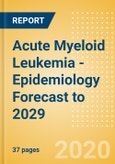Acute myeloid leukemia (AML) is a cancer of the blood and bone marrow in which the bone marrow produces abnormal red blood cells, white blood cells, or platelets, and generally progresses at a rapid pace. AML is more common in the elderly, is associated with severe complications and high mortality, and accounts for a disproportionately high number of cancer-related deaths. AML is often called acute myelogenous leukemia, acute myeloblastic leukemia, acute granulocytic leukemia, and acute nonlymphocytic leukemia.
In 2019, there were 72,164 diagnosed incident cases of AML in the 8MM in men and women combined for ages 18 years and older. The publisher's epidemiologists estimate that globally, cases will rise to 90,264 at an Annual Growth Rate (AGR) of 2.51% by 2029. Urban China is expected to contribute the highest proportion of growth over this forecast period with diagnosed incident cases growing from 29,535 in 2019 to 39,991 in 2029 at an AGR of 3.54%. Similarly, the five-year diagnosed prevalent cases of AML in the 8MM are expected to grow from 99,624 cases to 124,065 cases by 2029.
Scope
- This report provides an overview of the risk factors, comorbidities, and global and historical trends for AML in the eight major markets (8MM) (US, France, Germany, Italy, Spain, UK, Japan, and urban China). It includes a 10-year epidemiological forecast for the diagnosed incident cases of AML segmented by sex, and age by 10-year age groups beginning at age 18 years. The diagnosed incident cases of AML are also segmented by prognostic risk group (favorable-risk, intermediate-risk, and high-risk), and by type (secondary AML and acute promyelocytic leukemia [APL]).
- Additionally, this forecast provides the five-year diagnosed prevalent cases of AML. The accompanying epidemiology forecast model includes additional analysis on the diagnosed incident cases of AML, with associated mutations and biomarkers FLT3, IDH1, IDH2, BCR-ABL1/t(9;22)(q34.1;q11.2) translocation, CD-33, and CBF-AML with KIT mutation.
- The AML epidemiology report is written and developed by Masters- and PhD-level epidemiologists.
- The Epidemiology Report is in-depth, high quality, transparent and market-driven, providing expert analysis of disease trends in the 8MM.
Reasons to Buy
The AML Epidemiology series will allow you to -
- Develop business strategies by understanding the trends shaping and driving the global AML market.
- Quantify patient populations in the global AML market to improve product design, pricing, and launch plans.
- Organize sales and marketing efforts by identifying the age groups that present the best opportunities for AML therapeutics in each of the markets covered.
- Understand magnitude of secondary AML and APL.








